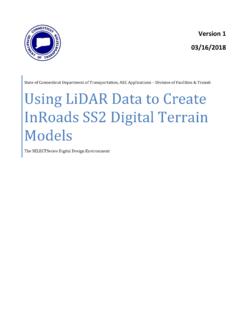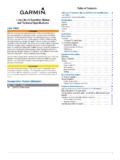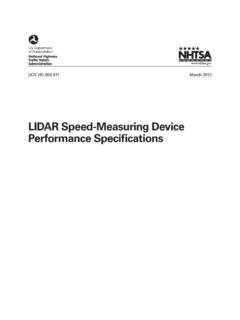Transcription of ADVANCED LIDAR DATA PROCESSING WITH …
1 ADVANCED LIDAR data PROCESSING with lastools . C. Hug a,*, P. Krzystek b , W. Fuchsc a GeoLas Consulting, Sultenstra e 3, D-85586 Poing, Germany b Department of Geoinformatics, Munich University of Applied Sciences, Karlstra e 6, D-80333 Munich, Germany - c fpi fuchs Ingenieure GmbH, Aachener Stra e 583, D-50226 Frechen K nigsdorf, Germany - @fpi KEY WORDS: LIDAR , PROCESSING , Software, DEM/DTM, Classification, Segmentation, Digital, Orthoimage ABSTRACT: This paper introduces lastools , a new software suite for the operational PROCESSING of data from ADVANCED airborne LIDAR sensor systems. lastools provides the tools required to generate DSMs and DTMs from raw or basically preprocessed LIDAR data in a stand- alone application. It features intelligent management of project data , import and geocoding of raw LIDAR and image data , system calibration, filtering and classification of LIDAR data , generation of elevation models, and the export of the results in various common formats.
2 Special emphasis is laid on an intuitive graphical user interface and streamlined workflow to enable efficient and rapid production. Additionally, lastools provides features for the handling and PROCESSING of ADVANCED LIDAR data like return signal waveforms and true surface color, as well as the rapid integration of LIDAR and digital image data into digital orthoimages. The paper describes the approach taken by lastools to efficiently organize and handle the large amounts of data generated by emerging ADVANCED LIDAR systems with waveform sampling and digital image registration. It discusses the segmentation-based object-oriented filtering technique at the heart of the lastools classification engine that achieves a high degree of automation for LIDAR point classification and feature extraction. The user interface philosophy for rapid data visualization and highly efficient interactive editing is highlighted.
3 Finally, the instruments for quality control incorporated into lastools at all stages of the PROCESSING workflow are presented. 1. INTRODUCTION Finally, new requirements for LIDAR PROCESSING software are on the horizon due to new hardware capabilities (integrated Motivation high-resolution digital cameras, or waveform digitization). They demand flexible data and PROCESSING structures to Airborne LIDAR mapping has been gaining widespread handle the explosively expanding data volumes efficiently acceptance during the last several years. While there are a and to make best use of the additional information that number of established manufacturers offering standard LIDAR becomes available through these technologies. instrumentation, LIDAR data PROCESSING is mostly still done using proprietary in-house developments of the service Our goal with lastools is to provide a next-generation.
4 Providers. Obviously, service providers have little interest integrated LIDAR PROCESSING environment that addresses these in making their developments available to the general issues and puts an emphasis on ease-of-use and efficient market, and thus potentially to competitors in their own production. field. Therefore, the market of commercially available LIDAR PROCESSING software is to date quite small, with Terrasolid Overview Oy of Finnland offering the only LIDAR -specific products that cover LIDAR PROCESSING in some breadth. Other remote- In its first incarnation, lastools handles LIDAR data sensing software packages are beginning to include limited PROCESSING from the egg (raw data ) to the chicken (elevation LIDAR data support. However, most of these only provide models, orthoimages), integrated with a project management tools for the regularization of LIDAR points ( gridding) and quality control framework.
5 And for bare-earth filtering/classification but do not address typical tasks specific to LIDAR data PROCESSING like Following PROCESSING features are available: geocoding and strip adjustment. A framework that handles raw data geocoding the entire production workflow is so far not available. calibration and strip adjustment model adjustment and ground control Furthermore, we have had to observe shortcomings in user classification interfaces of most of the currently available LIDAR PROCESSING model generation systems and LIDAR add-on components to other remote- orthoimage generation sensing software packages with regards to intuitivness and datum transformation and projection efficiency, which put high demands for training and education on the potential users and make the production On the project management side lastools provides process un duly tedious. workflow management storage resource management * Corresponding author.
6 Paper presented at the XXth ISPRS Congress, 12-23. July 2004, Istanbul, Turkey quality control Regions and blocks are defined by their perimeters (outline documentation and report generation polygons) that are imported when a project is created. simultaneous multi-user and network capabilities During import of track data (or its creation in the process of flexible process scheduler for running time-consuming geocoding), outline polygons of tracks are generated to tasks automatically during suitable periods allow easy access to track-related information at later PROCESSING stages when data of multiple tracks has been The user meets a consistent, easy-to-use interface, including merged. graphical project organizer, process scheduler, and workflow monitor fast and flexible data viewer giving visual access to the data in a variety of display modes in multiple synchronized windows and with efficient display control mechanisms, intuitive and efficient data editor with instant visual feedback for interactive operations comprehensive online help features on several levels.
7 lastools is able to manage, process, and visualize 3D-point, vector, 2D-raster, and volume data simultaneously. Therefore, it is ready to handle the output of ADVANCED LIDAR systems recording echo waveforms. An open data interface architecture allows lastools to be easily expanded with additional PROCESSING capabilities in the future, as well as giving third-party developers and users with special requirements access for customized applications. Within the scope of this paper, we will focus on two aspects of lastools in more detail: project management and classification. 2. PROJECT AND data MANAGEMENT. Project Organization and data Management A project in lastools is organized as one or several regions, each of which contains one or more blocks. Blocks are Figure 2. Subblock file layout considered elementary coherent survey areas. data is acquired in flights (between one takeoff and landing) The geocoded LIDAR measurement points are held and collecting one or more tracks of data that may cover a single organized in blocks.
8 Blocks are subdivided into square or multiple blocks. While flights and tracks result from subblocks for manageable file sizes (subblocks are th e sequential data acquisition and thus represent the temporal storage units) which themselves are divided into tiles for structure of a project, regions and blocks reflect its spatial rapid location-based access. Subblock files hold in a meta- organization. A flight will usually be done with a single data structure basic LIDAR data (point coordinates) and LIDAR sensor and one set of calibration values. A block may, attribute information (time stamps, track identifier, return however, contain data from several flights with different signal intensity, surface point color, point class, etc.) in sensors and calibration sets. lastools maintains a database multiple segments or layers. The sequence of data in all that relates flights, tracks, blocks, and regions with the layers is identical allowing the relevant information of any relevant sensor descriptions and calibration data sets.
9 Point to be accessed directly and rapidly by indexing from the layer start while maintaining a fully bi-directional relationship between coordinates and attribute values on the level of single measurements. This organization also makes it easy to include additional attributes without having to change the basic file structure and access mechanisms. For example, the inclusion of digitized waveform data from the ADVANCED LIDAR systems is easily accomplished as an additional layer of data . For each laser measurement, a variable-length array of waveform samples plus azimuth and incidence angle values of the beam direction and the coordinate of the last sample is appended to the subblock files. While file sizes increase substantially by including waveform data , the layered organization of the files does not require the entire file to be read for performing geometric operations, so PROCESSING speed is not compromised.
10 To further speed up data access and display at coarser levels, Figure 1. Project layout each subblock contains aggregated surface height, height difference, intensity and color information at several resolutions in a data pyramid. lastools manages subblocks invisibly to the user, who may select any area (rectangular, polygonial or linear) within a block for display and PROCESSING and may pan and zoom the display freely over the entire block without having to work with subblocks or even encountering their traces in the displayed data . Workflow lastools handles all steps of the LIDAR data PROCESSING workflow from project setup to output of products and provides guidance and support to the user on required steps, production progress, quality control, and report generation. The first step in the workflow is project preparation. It involves setting up a project by defining its location in a computer environment, and creating the required directory structures (which happens automatically); a new project may be created from scratch or as a copy of an existing project if some of the parameters used in the old project also apply to the new project, importing project-defining data (perimeters, target coordinate system(s) and projections, flight plans, products, output formats and tiling requirements, Figure 3.)





